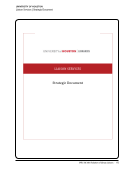30 · Survey Results: Survey Questions and Responses
Public services
Public services division
Public Services Division, front line staff
Report to heads of branch libraries, and in some cases, a supervisor under the branch head.
Scattered across the organization working collaboratively.
Subject Librarians, our liaisons, report to a subject team leader (Area Studies, Humanities, Science, Social Sciences) and
live in the Services Division. The Services Division includes Collections, Outreach &Education, and Access (Circ., REF,
ILL, etc.)
The Academic Liaison Program (ALP) Director reports directly to the AUL of Academic Services. The AUL reports directly
to the UL. The ALP oversees the liaison work of all librarians however not all liaisons report primarily to the ALP. All
liaisons have similar core functions and duties, and some report to the ALP while others report to other service programs
such as Collection Development and Management or Reference and Research Advisory Services.
The bulk of the liaisons (called “selectors”) are in the Research Department although we have many in Technical
Services, Learning &Teaching, Health Sciences library, and Publishing.
The bulk of the liaisons report to University Libraries Associate Dean for User Services or the Assistant Dean for the
Medical Sciences Library. Some area studies and language liaison duties are dispersed across other units.
The liaison librarians work in the Education and Outreach, Reference, and Collection Development departments.
The Liaison Services Department is in the Public Services division (reporting to AD for public services) and consists of
both subject and functional (e.g., instruction, collections) specialists. It is co-managed by two department heads (Head
of Liaison Services for Collections &Research Support and Head of Liaison Services for Instruction &Outreach). Branch
libraries are not part of Liaison Services.
The liaisons report directly to the Team Leader for Research Services who reports to the Associate Director for Academic
Engagement Services.
There is no linear reporting line but most are in areas focused on public services.
They are an extra-departmental team of faculty librarians with an elected chair and an advisory group of ex
officio members.
They reside in departments such as reference as well as in area studies and specialized departments and there are a few
in technical services areas.
They sit under the Information Services &Resources departments. These departments report to the Associate University
Librarian, Information Resources &Academic Excellence.
Throughout the organization and across many of the departments
Two departments—Research and Instructional Services and Area and International Studies—are primarily comprised
of liaisons. Both departments report to the AUL for Collections and Public Services. There are also liaisons in several
branch libraries.
Typically liaison librarians report to the Campus Library director some liaisons are not in a campus library, but report to
the Director of Scholarly Communications, or the director of library digital services.
Under the Assistant Dean for Scholarly Communication and Collections in a group with collection development
Public services
Public services division
Public Services Division, front line staff
Report to heads of branch libraries, and in some cases, a supervisor under the branch head.
Scattered across the organization working collaboratively.
Subject Librarians, our liaisons, report to a subject team leader (Area Studies, Humanities, Science, Social Sciences) and
live in the Services Division. The Services Division includes Collections, Outreach &Education, and Access (Circ., REF,
ILL, etc.)
The Academic Liaison Program (ALP) Director reports directly to the AUL of Academic Services. The AUL reports directly
to the UL. The ALP oversees the liaison work of all librarians however not all liaisons report primarily to the ALP. All
liaisons have similar core functions and duties, and some report to the ALP while others report to other service programs
such as Collection Development and Management or Reference and Research Advisory Services.
The bulk of the liaisons (called “selectors”) are in the Research Department although we have many in Technical
Services, Learning &Teaching, Health Sciences library, and Publishing.
The bulk of the liaisons report to University Libraries Associate Dean for User Services or the Assistant Dean for the
Medical Sciences Library. Some area studies and language liaison duties are dispersed across other units.
The liaison librarians work in the Education and Outreach, Reference, and Collection Development departments.
The Liaison Services Department is in the Public Services division (reporting to AD for public services) and consists of
both subject and functional (e.g., instruction, collections) specialists. It is co-managed by two department heads (Head
of Liaison Services for Collections &Research Support and Head of Liaison Services for Instruction &Outreach). Branch
libraries are not part of Liaison Services.
The liaisons report directly to the Team Leader for Research Services who reports to the Associate Director for Academic
Engagement Services.
There is no linear reporting line but most are in areas focused on public services.
They are an extra-departmental team of faculty librarians with an elected chair and an advisory group of ex
officio members.
They reside in departments such as reference as well as in area studies and specialized departments and there are a few
in technical services areas.
They sit under the Information Services &Resources departments. These departments report to the Associate University
Librarian, Information Resources &Academic Excellence.
Throughout the organization and across many of the departments
Two departments—Research and Instructional Services and Area and International Studies—are primarily comprised
of liaisons. Both departments report to the AUL for Collections and Public Services. There are also liaisons in several
branch libraries.
Typically liaison librarians report to the Campus Library director some liaisons are not in a campus library, but report to
the Director of Scholarly Communications, or the director of library digital services.
Under the Assistant Dean for Scholarly Communication and Collections in a group with collection development












































































































































































































